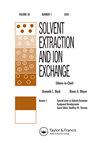Hydrodynamic Properties of Tris(2-methylbutyl) Phosphate and Tri-n-alkyl Phosphates in n-Dodecane – A Comparative Investigation between Unirradiated and Gamma Irradiated Solvent Systems
IF 2.1
4区 化学
Q3 CHEMISTRY, MULTIDISCIPLINARY
引用次数: 4
Abstract
ABSTRACT The physicochemical parameters of tris(2-methylbutyl) phosphate (T2MBP), a molecule possessing the essential characteristics required to be considered as a promising extractant in the solvent extraction stage of fast reactor fuel reprocessing, have been evaluated in the present study. In this context, the density, viscosity and interfacial tension (IFT), which are considered to be few among the important solvent selection criteria prior to its deployment in the plant scale have been measured for T2MBP in n-dodecane (n-DD) based systems. Similar studies have been performed with its straight chain isomer, tri-n-amyl phosphate (TAP) as well as the widely utilized commercial extractant, tri-n-butyl phosphate (TBP) so as to emphasize on the structural effects. Though the trends on the physicochemical behaviour of TBP based systems (temperature and ligand concentration effects) are well known in the literature, the data on TBP have been generated in the present work for comparison with the T2MBP results under similar experimental conditions. Solutions of trialkyl phosphates (TalP) in n-DD of different concentrations have been used to generate the data on the variation of density, IFT and viscosity with the change in the ligand concentration. In addition, the transformation in their properties has been assessed after subjecting the solvents to various levels of gamma absorbed doses. Overall, it has been observed that there was no significant variation in the density of the irradiated TalPs; however, there was a significant rise in the viscosity and reduction in the IFT of the TalP samples upon irradiation. The data on the Gibbs energy change of activation of various 1.1 M TalP/n-DD solutions have been generated by fitting their respective dynamic viscosity value as a function of temperature using Andrade’s equation. Moreover, from the IFT value, the parameters relating to the interfacial activity of TalP/n-DD solutions have been determined using the Szyszkowski adsorption isotherm.正十二烷中磷酸三(2-甲基丁基)酯和磷酸三正烷基酯的水动力学性质——未辐照和γ辐照溶剂体系的比较研究
摘要本研究对磷酸三(2-甲基丁基)酯(T2MBP)的物理化学参数进行了评估,该分子具有在快堆燃料后处理溶剂萃取阶段被认为是一种有前途的萃取剂所需的基本特性。在这种情况下,已经在基于正十二烷(n-DD)的系统中测量了T2MBP的密度、粘度和界面张力(IFT),这些在其在工厂规模部署之前被认为是重要的溶剂选择标准中很少的。对其直链异构体磷酸三正丁酯(TAP)以及广泛使用的商业萃取剂磷酸三正丁基酯(TBP)进行了类似的研究,以强调其结构效应。尽管基于TBP的系统的物理化学行为的趋势(温度和配体浓度效应)在文献中是众所周知的,但在本工作中已经生成了TBP的数据,以与类似实验条件下的T2MBP结果进行比较。磷酸三烷基酯(TalP)在不同浓度的n-DD中的溶液已被用于生成密度、IFT和粘度随配体浓度变化的数据。此外,在对溶剂进行不同水平的伽马吸收剂量后,对其性质的转变进行了评估。总体而言,已经观察到辐照的滑石粉的密度没有显著变化;然而,辐照后TalP样品的粘度显著升高,IFT降低。关于各种1.1M TalP/n-DD溶液的活化吉布斯能变化的数据是通过使用安德拉德方程拟合它们各自的动态粘度值作为温度的函数而产生的。此外,根据IFT值,已经使用Szyszkowski吸附等温线确定了与TalP/n-DD溶液的界面活性相关的参数。
本文章由计算机程序翻译,如有差异,请以英文原文为准。
求助全文
约1分钟内获得全文
求助全文
来源期刊
CiteScore
4.40
自引率
5.00%
发文量
15
审稿时长
8.4 months
期刊介绍:
Solvent Extraction and Ion Exchange is an international journal that publishes original research papers, reviews, and notes that address all aspects of solvent extraction, ion exchange, and closely related methods involving, for example, liquid membranes, extraction chromatography, supercritical fluids, ionic liquids, microfluidics, and adsorption. We welcome submissions that look at: The underlying principles in solvent extraction and ion exchange; Solvent extraction and ion exchange process development; New materials or reagents, their syntheses and properties; Computational methods of molecular design and simulation; Advances in equipment, fluid dynamics, and engineering; Interfacial phenomena, kinetics, and coalescence; Spectroscopic and diffraction analysis of structure and dynamics; Host-guest chemistry, ion receptors, and molecular recognition.

 求助内容:
求助内容: 应助结果提醒方式:
应助结果提醒方式:


